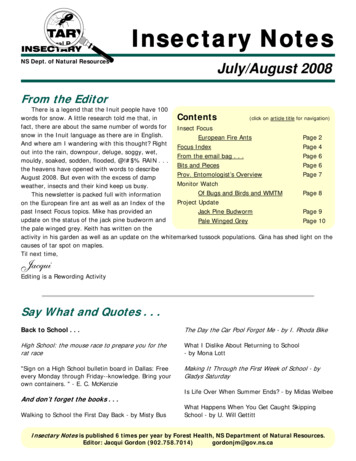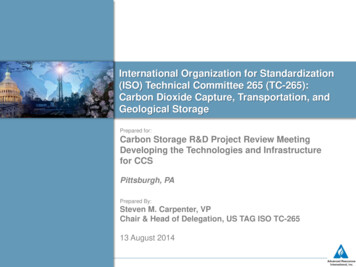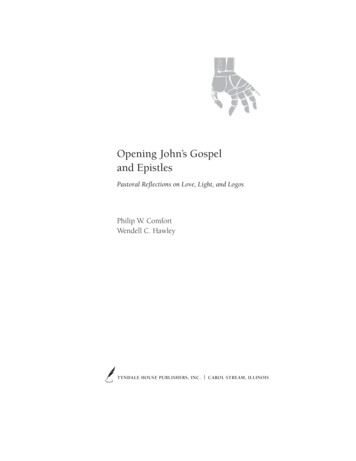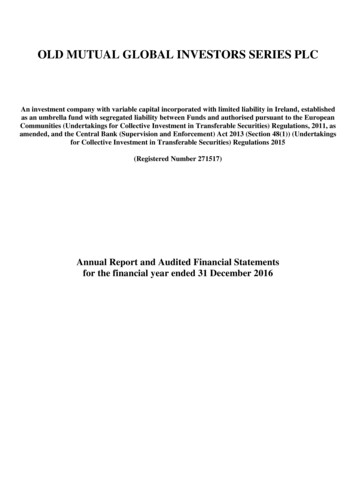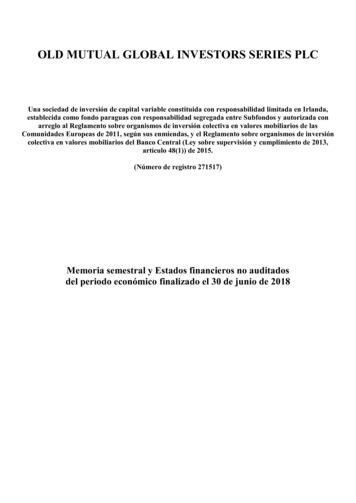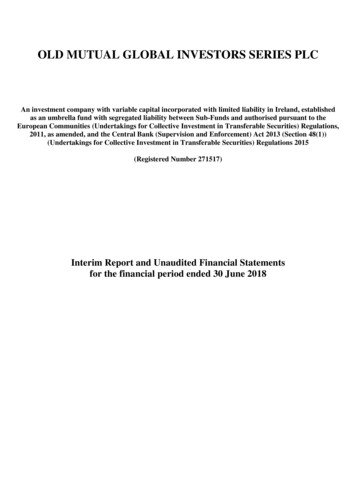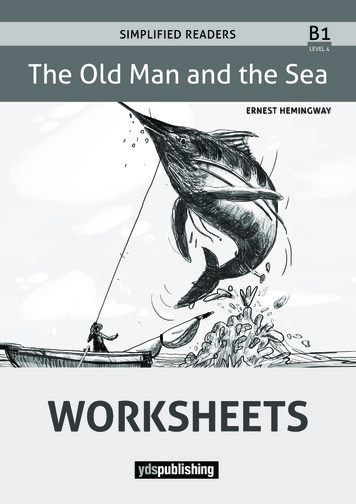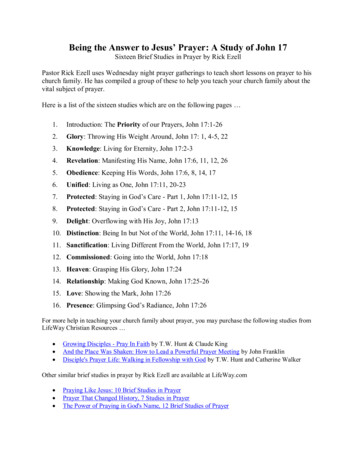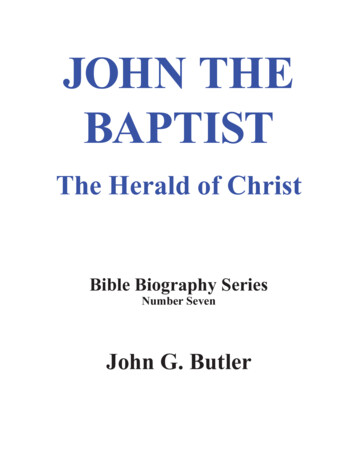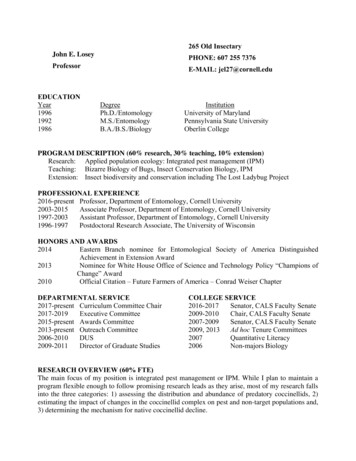
Transcription
265 Old InsectaryJohn E. LoseyPHONE: 607 255 7376ProfessorE-MAIL: itutionUniversity of MarylandPennsylvania State UniversityOberlin CollegePROGRAM DESCRIPTION (60% research, 30% teaching, 10% extension)Research: Applied population ecology: Integrated pest management (IPM)Teaching: Bizarre Biology of Bugs, Insect Conservation Biology, IPMExtension: Insect biodiversity and conservation including The Lost Ladybug ProjectPROFESSIONAL EXPERIENCE2016-present Professor, Department of Entomology, Cornell University2003-2015Associate Professor, Department of Entomology, Cornell University1997-2003Assistant Professor, Department of Entomology, Cornell University1996-1997Postdoctoral Research Associate, The University of WisconsinHONORS AND AWARDS2014Eastern Branch nominee for Entomological Society of America DistinguishedAchievement in Extension Award2013Nominee for White House Office of Science and Technology Policy “Champions ofChange” Award2010Official Citation – Future Farmers of America – Conrad Weiser ChapterDEPARTMENTAL SERVICE2017-present Curriculum Committee Chair2017-2019Executive Committee2015-present Awards Committee2013-present Outreach Committee2006-2010DUS2009-2011Director of Graduate StudiesCOLLEGE SERVICE2016-2017Senator, CALS Faculty Senate2009-2010Chair, CALS Faculty Senate2007-2009Senator, CALS Faculty Senate2009, 2013Ad hoc Tenure Committees2007Quantitative Literacy2006Non-majors BiologyRESEARCH OVERVIEW (60% FTE)The main focus of my position is integrated pest management or IPM. While I plan to maintain aprogram flexible enough to follow promising research leads as they arise, most of my research fallsinto the three categories: 1) assessing the distribution and abundance of predatory coccinellids, 2)estimating the impact of changes in the coccinellid complex on pest and non-target populations and,3) determining the mechanism for native coccinellid decline.
PEER-REVIEWED PUBLICATIONS*All publications in this list were reviewed by an editor and anonymous peer reviewers*See “other publications” in this CV and Extension/Outreach for non-peer-reviewed publicationsPublished and Accepted73.72.71.70.69.68.67.66.65.Youngerman, C.Z., A. DiTommaso, J.E. Losey, and M.R. Ryan. (2019 - accepted on 22Mar 2019). Cover crop seed preference of four common weed seed predators. RenewableAgriculture and Food Systems.Ugine, T. A., Krasnoff, S. B., Grebenok, R. J., Behmer, S. T., & Losey, J. E. (2019). Preynutrient content creates omnivores out of predators. Ecology Letters. 22:275-283.Lee, B. W., Ugine, T. A., & Losey, J. E. (2018). An assessment of the physiological costs ofautogenous defenses in native and introduced lady beetles. Environmental Entomology.47:1030-1038.Park, M.G., Joshi, N.K., Rajotte, E.G., Biddinger, D.J., Losey, J.E. and Danforth, B.N.,2018. Apple grower pollination practices and perceptions of alternative pollinators in NewYork and Pennsylvania. Renewable Agriculture and Food Systems, pp.1-14.Ugine, T.A., Hoki, E., & Losey, J. E. (2018). Interactions of Coccinella novemnotata(Coleoptera: Coccinellidae) and Coccinella septempunctata (Coleoptera: Coccinellidae)While foraging for aphids. Environmental Entomology. 47:87-92.Woodbury, P. B., DiTommaso, A., Thies, J., Ryan, M., & Losey, J. (2017). Effects ofTransgenic Crops on the Environment. Environmental Pest Management: Challenges forAgronomists, Ecologists, Economists and Policymakers, 131.Ducatti, R. D. B., Ugine, T. A., & Losey, J. (2017). Interactions of the Asian Lady Beetle,Harmonia axyridis (Coleoptera: Coccinellidae), and the North American Native LadyBeetle, Coccinella novemnotata (Coleoptera: Coccinellidae): Prospects for Recovery PostDecline. Environmental Entomology. 46:21-29.Haelewaters, D., Zhao, S.Y., Clusella-Trullas, S., Cottrell, T.E., De Kesel, A., Fiedler, L.,Herz, A., Hesketh, H., Hui, C., Kleespies, R.G. and Losey, J.E., (2016). Parasites ofHarmonia axyridis: current research and perspectives. BioControl. 1:1-17.DiTommaso, A., Averill, K., Hoffmann, M., Fuchsberg, J. and Losey, J. (2016). Integratinginsect, resistance, and floral resource management in weed control decision-making. WeedScience 64:743-756.64.HE Roy, PMJ Brown, T Adriaens, N Berkvens, I Borges, S Clusella-Trullas, RF Comont, P De Clercq,R Eschen, A Estoup, EW Evans, B Facon, MM Gardiner, A Gil, AA Grez, T Guillemaud, D Haelewaters, AHerz, A Honek, AG Howe, C Hui, WD Hutchison, M Kenis, RL Koch, J Kulfan, LL Handley, E Lombaert, ALoomans, J Losey, AO Lukashuk, DMaes, A Magro, KM Murray, G San Martin, Z Martinkova, IA Minnaar,O Nedved, MJ Orlova-Bienkowskaja, N Osawa, W Rabitsch, HP Ravn, G Rondoni, SL Rorke, SK Ryndevich,M Saethre, JJ Sloggett, AO Soares, R Stals, MC Tinsley, A Vandereycken, P van Wielink, S Viglášová, PZach, IA Zakharov, T Zaviezo, Z Zhao. (2016). The harlequin ladybird, Harmonia axyridis: globalperspectives on invasion history and ecology. Biological Invasions (2016) 18: 997. doi:10.1007/s10530-0161077-6.63.Diepenbrock, L. M., Fothergill, K., Tindall, K. V., Losey, J. E., Smyth, R. R., & Finke, D. L.(2016). The Influence of Exotic Lady Beetle (Coleoptera: Coccinellidae) Establishment onthe Species Composition of the Native Lady Beetle Community in Missouri. EnvironmentalEntomology. 45:855-864.
rk, M. G., Raguso, R. A., Losey, J. E., & Danforth, B. N. (2016). Per-visit pollinatorperformance and regional importance of wild Bombus and Andrena (Melandrena) comparedto the managed honey bee in New York apple orchards. Apidologie. 47:145-160.Park, M. G., Blitzer, E. J., Gibbs, J., Losey, J. E., & Danforth, B. N. (2015). Negative effectsof pesticides on wild bee communities can be buffered by landscape context. Proc. R. Soc. B282:20150299.Turnipseed, R., T. Ugine, and J.E. Losey. (2015). Egg predation by the invasive lady beetle,Coccinella septempunctata (Coleoptera:Coccinellidae), lowers mortality but raises relativerisk for the native lady beetle, Coccinella novemnotata. PloS one 10 (6), e0118493.Tumminello, G., T. Ugine, and J.E. Losey. (2015). Intraguild Interactions of Native andIntroduced Coccinellids: The Decline of a Flagship Species. Environmental Entomology.44:64-72.Brandt, D.M., P.J. Johnson, J.E. Losey, M.A. Catangui, and L.S. Hesler. (2015).Development and survivorship of a predatory lady beetle, Coccinella novemnotata, on variousaphid diets. BioControl 60:221-229.DiTommaso, A., M. Ryan, C.L. Mohler, D.C. Brainard, L.L. Allee, and J.E. Losey. (2014).Effect of Cry3Bb transgenic maize and tefluthrin on post-dispersal weed seed predation.Weed Science. 62:619-624.Sickler, J., T.M. Cherry, J.E. Losey, L. Allee, and, R. R. Smyth. (2014). Scientific valueand educational goals: balancing priorities and increasing adult engagement in a citizenscience project . Applied Environmental Education Communication. 13:109-119.Turnipseed, R., T. Ugine, and J.E. Losey. (2014). Effect of prey limitation on competitiveinteractions between a native lady beetle, Coccinella novemnotata, and invasive lady beetle,Coccinella septempunctata (coleoptera: coccinellidae). Environmental Entomology.43:969-976.Ugine, T., and J.E. Losey. (2014). Development times and age-specific life tableparameters of the native lady beetle species Coccinella novemnotata(Coleoptera:Coccinellidae) and its invasive congener Coccinella septempunctata(Coleoptera:Coccinellidae). Environmental Entomology. 43:1067-1075.Fox, T.B., M. Caillaud, and J.E. Losey. Temperature and host condition affect phenotypicplasticity in the pea aphid (Acyrthosiphon pisum) (Homoptera: Aphididae). (Accepted:Journal of Insect Science 4/4/14).Losey, J.E., E. Stephens, L. Allee, P. Priolo, R. Smyth and L. Stellwag. (2014). Ladybeetles in New York: Insidious invasions, erstwhile extirpations, and recent rediscoveries.Northeastern Naturalist. 21:271-284.Hesler, L.S., J.E. Losey, L.L Allee, and R.R. Smyth. (2014). New records of Coccinellidae(Coleoptera) from Wyoming, Usa. Coleopterist Bulletin. 68:1-3.Stellwag, R., and J.E. Losey. (2014). Assessment of sexual dimorphism within the genusCoccinella (Coleopter: Coccinellidae) in North America. Coleopterist Bulletin. 68:271-281.Hoki, E., J.E. Losey, and T. Ugine. (2014). Comparing the consumptive and non-consumptiveeffects of a native and introduced lady beetle on pea aphids (Acyrthosiphon pisum). BiologicalControl. 70:78-84.Smyth, R., J.E. Losey, and L. Allee. (2013). The status of Coccinella undecimpunctata (L.)(Coleopter: Coccinellidae) in North America: An updated distribution and new method ofassessment. The Coleopterist Bulletin. 67:532-535.Stephens, E.J., J.E. Losey, L. Allee, A. DiTommaso, C. Bodner, and A. Breyre. (2012). Theimpact of Cry 3Bb1 Bt-maize on two guilds of beneficial beetles. Agriculture, Ecosystems,and Environment. 156:72-81.
msey, S., and J. Losey. (2012). Why is Harmonia axyridis the culprit in coccinellid bitingincidents? An analysis of means, motive and opportunity. American Entomologist. 58:166170.Hesler, L.S., G. McNickle, M.A. Catangui, J.E. Losey, E.A. Beckendorf, L. Stellwag, D.M.Brandt, and P.B. Bartlett. (2012). Method for Continuously Rearing Coccinella Lady Beetles(Coleoptera: Coccinellidae). Open Entomology Journal. 6:42-48.Gardiner, M., L. Allee, P. Brown, J. Losey, H. Roy, and R. Smyth. (2012). Lessons fromlady beetles: Accuracy of monitoring data from US and UK citizen science programs.Frontiers in Ecology and the Environment. 10:471-476.Losey, J.E., L. Allee, and R. Smyth. (2012). The Lost Ladybug Project: Citizen spottingsurpasses scientist’s surveys. American Entomologist. 58:22-24.Losey, J., J. Perlman, J. Kopco, S. Ramsey, L. Hesler, E. Evans, L. Allee, and R. Smyth.(2012). Potential causes and consequences of decreased body size in field populations ofCoccinella novemnotata. Biological Control. 61:98-103. (published in advance online in2011)Finkbeiner, S.D., R.D. Reed, R. Dirig, and J. E. Losey. 2011. The role of environmentalfactors in the Northeastern range expansion Papilio cresphontes Cramer (Papilionidae).Journal of the Lepidopterist Society 65:119-125.Hesler , L.S., K. Fothergill, K.V. Tindall , and J. E. Losey. 2010. Novel elytral-color formsof Coccinella septempunctata (Coleoptera: Coccinellidae) in North America. Proc. Ent. Soc.Wash. 112:500-507.Denemark, E., and J.E. Losey. 2010. Causes and consequences of ladybug washups in theFingerlakes region of New York State (Coleoptera: Coccinellidae). Entomologica Americana.116:78-88.Fothergill, K. W. Moore, J. Losey, L. L. Allee and R. R. Smyth. 2010. First Arizona recordsof the multicolored Asian lady beetle, Harmonia axyridis (Pallas) (Coleoptera:Coccinellidae). The Coleopterists Bulletin. 64 (1): 51-52.Caillaud M.C. and J.E. Losey. 2010. Genetics of color polymorphism in the pea aphid,Acyrthosiphon pisum. Journal of Insect Science 10:95, available online:insectscience.org/10.95 (Open source; no hard copy).Hesler, L.S., M.A. Cantangui, J.E. Losey, J. B. Helbig and A. Mesman. 2009. Recent recordsof Adalia bipnctata (L.), Coccinella transversoguttata Richardsoni Brown, and Coccinellanovemnotata Herbst (Coleoptera: Coccinellidae) from South Dakota and Nebraska. TheColeopterists Bulletin, 63(4):475–484. 2009.Losey, J. and M. Vaughan. 2008. Conserving the ecological services provided by insects.American Entomologist 54: 113-115.Vaughan, M., F. Kuehn, J. Losey, and S. Black. 2008. Conservation of Insects. AmericanEntomologist 54: 96-97.Shuler, R.E., A. DiTommaso, J.E. Losey, and C.L. Mohler. 2008. Postdispersal weed seedpredation is affected by experimental substrate. Weed Science 56: 889-895.Losey, J.E., J.E. Perlman, and R. Hoebeke. 2007. Citizen scientist rediscovers rare ninespotted lady beetle, Coccinella novemnotata, in eastern North America. Journal of InsectConservation. 11:415-417.Fuchsberg, J.R., T.-H. Yong, J.E. Losey, M.E. Carter, and M.P. Hoffmann. 2007. Evaluationof corn leaf aphid (Rhopalosiphum maidis; Homoptera: Aphididae) honeydew as a foodsource for the egg parasitoid Trichogramma ostriniae (Hymenoptera: Trichogrammatidae).
ological Control 40(2): 230-236.Hayden, V.R., J.M. Duxbury, A. DiTommaso, and J.E. Losey. 2007. Weed CommunityDynamics in the System of Rice Intensification (SRI) and the Efficacy of MechanicalCultivation and Competitive Rice Cultivars for Weed Control in Indonesia. Journal ofSustainable Agriculture 30:5-26.Harmon, J. E., J. Stephens, and J. Losey. 2007. The decline of native coccinellids (Coleoptera:Coccinellidae) in the United States and Canada. Journal of Insect Conservation. 11:85-84.Hoffmann, M. P., S. A. Pitcher, S. A. Cheever, J. E. Losey, T. P. Kuhar; C. A. Laub, and R.R. Youngman. 2006. Efficacy of inoculative releases of Trichogramma ostriniae(Hymenoptera: Trichogrammatidae) against European corn borer Ostrinia nubilalis(Lepidoptera: Crambidae) in field corn. Biological Control 36: 345-349.Losey, J.E., and M. Vaughan. 2006. The economic value of ecological services provided byinsects. BioScience 56:311-323.E.J. Stephens, and J.E. Losey. 2004. Comparison of sticky cards, visual and sweep samplingfor assessment of coccinellid populations in alfalfa. Environmental Entomology 33:535-539.Carter, M.E., M.G. Villani, L.L. Allee, and J.E. Losey. 2004. Absence of non-target effectsof Bacillus thuringiensis coleopteran active endotoxins to the bulb mite, Rhizoglypus robini(Claperede) (Acari, Acaridae). Journal of Applied Entomology. 128:56-63Losey, J.E., R.A. Hufbauer, and R.G. Hartzler. 2003. Enumerating lepidopteran speciesassociated with maize as a first step in risk assessment. Environmental Biosafety Research2:247-261.DiTommaso, A. and J.E. Losey. 2003. Potential impact of two invasive swallow-worts,Vincetoxicum rossicum and Vincetoxicum nigrum on monarch butterfly (Danaus plexippus)populations. Entomologia Experimentalis et applicata 108:205-209.Losey, J.E., L.L. Allee, V. Zbarsky, J.K. Waldron, and E.J. Shields. 2003. Transect samplingto enhance efficiency of corn rootworm (Coleoptera: Chrysomelidae) monitoring. Journal ofEconomic Entomology. 96:1420-1425.Losey, J.E, J. K. Waldron, E. R. Hoebeke, L. E. Macomber, and B. N. Scott. 2002. Firstrecord of the soybean aphid, Aphis glycines Matsumura (Hemiptera: Sternorrhyncha:Aphididae), in New York. The Great Lakes Entomologist 35:101-105.Losey, J.E., M.E. Carter, and S.A. Silverman. 2002. The affect of stem diameter on Europeancorn borer behavior and survival: Consequences for IRM in Bt-corn. EntomologiaExperimentalis et Applicata 105:89-96.Teulon, D.A.J. and J.E. Losey. 2002. Issues relating to the practical use of transgenic cropsfor insect pest management. New Zealand Plant Protection 55:396-404.Losey, J.E., D.D. Calvin, M.E. Carter, and C.E. Mason. 2001. Evaluation of non-corn hostplants as a refuge in a resistance management program for European corn borer (Lepidoptera:Crambidae) on Bt-corn. Environmental Entomology 30:728-735.Jensen, M.A., J.E. Losey and A.E. Hajek. 2001. Altered behavior and distribution of peaaphids, Acyrthosiphon pisum (Homoptera: Aphididae), infected with Pandora neoaphidus(Zugomycetes: Entomophthorales). BioControl 46:337-343.Obrycki, J.J., J.E. Losey, O. Taylor, and L.C. Hansen. 2001. Transgenic insecticidal corn:Beyond insecticidal toxicity to ecological complexity. BioScience 51:353-361.Stanley-Horn, D.E., G.P. Dively, R.L. Hellmich, H.R. Mattila, M.K. Sears, R. Rose, L.C.H.Jesse, J.E. Losey, J.J. Obrycki, and L. Lewis. 2001. Assessing the impact of Cry1Abexpressing corn pollen on monarch butterfly larvae in field studies. Proceedings of theNational Academy of Sciences 98: 11931-11936.
12.11.5.Harmon J.P., A.R. Ives, J.E. Losey, A.C. Olson, and K.S. Rauwald. 2000. Coleomegillamaculata DeGeer (Coleoptera: Coccinellidae) predation on pea aphids promoted by proximityto dandelions. Oecologia 125:543-548.Losey, J.E., L.S. Rayor, and M.E. Carter. 1999. Transgenic pollen harms monarch larvae.Nature 399:214.Losey, J.E., A.R. Ives, J. Harmon, F. Ballantyne, and C. Brown. 1997. Maintenance of anaphid color polymorphism through a balance of parasitism and predation. Nature 388: 269272.GRANTS RECEIVEDSummary: Over 7 million in funding support in PI or co-PI projects since 2003. [amount to Losey - compiled from OSP portal]USDA/NIFA – Smith-Lever. 2019-2022. 88,335. Ladybugs and garden-based learning: Amulti-county 4H CCE project. (Losey, J)Department of Energy – SETO National Laboratory Call DE-LC-000L044. 2019-2022. 2,997,561 [ 108,000]. InSPIRE 2.0: Facilitating Low-Impact Solar Development throughData and Analysis for Environmental Resiliency and Compatibility. (PI: Jordan Macknick,National Renewable Energy Laboratory, CoPIs: H. Hartmann, Argonne National Laboratory, S.Herbert, University of Massachusetts, S. Ravi, Temple University, G. Barron-Gafford, Universityof Arizona, M. Lehan, Hyperion, A. Knapp, Colorado State University, J. Losey, CornellUniversity, A. Garrett, Oregon State University)USDA/NIFA – Hatch/Multistate NE1332. 2015-2018. 90,000 [ 90,000]. Biological Control ofArthropod Pests and Weeds. (Losey, J.)National Science Foundation – ISE. 2011-2015. 2,491,912 [ 2,260,078]. Broad implementationof the lost ladybug project: Integrating new places and new faces into a national lifelonglearning opportunity (Losey, J., L. Hesler, and K. Tilmon)USDA – NEIPM. 2011-2012. 19,923 [ 400]. Native pollinators of eastern apple orchards andhow to conserve them. (Losey, J, A. Agnello, B. Danforth, D. Biddinger and E. Rajotte)National Science Foundation – ISE. 2008-2012. 1,983,354 [ 1,361,145]. Have you spotted me:Learning Lessons by Looking for Ladybugs (Losey, J., L. Allee, L. Hesler, M. Catangui, andJ. Pickering)USDA – Hatch. 2007-2010. 60,000 [ 60,000]. Harmonia axyridis boon or bane: Assessing thepositive and negative impacts of an introduced ladybeetle. (Losey, J., L. Allee)USDA – NEIPM. 2006-2008. 79,740 [ 7,488]. Reducing Potato Leafhopper (PLH) Impacts onAlfalfa through PLH-resistant Cultivars intercropped with Perennial Forage Grass (Viands,Waldron, Losey, Hanchar, and Hansen)NE Soybean Board. 2005-2006. 10,000 [ 10,000]. Evaluation of Economic Injury Level,Biological Control, and Host Plant Resistance for Soybean Aphid in NY (Losey, J., K.Waldron, and A. Hajek)NE Soybean Board. 2004-2005. 15,979 [ 15,979]. Evaluation of Economic Injury Level,Biological Control, and Host Plant Resistance for Soybean Aphid in NY (Losey, J., K.Waldron, and A. Hajek)USDA – BRAP. 2003. 249,000: Beyond biodiversity: ecological function assessment in the Btcorn system. (Losey J., DiTommaso, J. Esnard, J. Thies, D. Peck, L. Allee, and M. Devare)Innovation in Teaching Grants Program. 2001. 60,000. Integrated pest management at Cornell:Using electronic media to enhance and extend learning and practice. (P. Trutmann, P.Arneson, A. DiTommaso, and Losey)
USDA – BRAP. 2001. 276,554. Assessing the comparative risk of CRW transgenic corn andchlorpyrifos to the soil microbial community. (J.E. Thies, J. Duxbury, M. Devare, J. Esnard,Losey, Allee)NE Soybean Board. 2001. 12,746. Survey and assessment of the soybean aphid in New York.(Losey, J., K. Waldron, and E.R. Hoebeke)Towards Sustainability Foundation. 2001. 2,000. Incorporating bats into an organic program tomanage the European corn borer, Ostrinia nubilalis. (E. Stephens – grad student, Losey)USDA – BRAP. 2000. 210,000: Assessing risk of Bt corn to Nontarget Soil Arthropods: Directand Indirect Effects. (Losey/Villani)USDA – NEIPM. 2000. 155,055: . Inoculative releases of Trichogramma ostriniae for control ofEuropean corn borer in field corn. (Losey and M. Hoffmann)USDA – NEIPM. 2000. 90,818. Incorporating Bt-corn hybrids into field crop IPM programs.(D.D. Calvin – Penn State, PI; 8,700 to Losey)USDA. 2000. 20,000: Regional monitoring and field level experiments to determine the riskposed to monarch butterflies from Bt corn (Losey)NYS IPM Program. 2000. 2,225: Transect sampling to enhance efficiency of corn rootwormmonitoring. (Losey,.J. K. Waldron, and P. Arneson)TEACHING OVERVIEW (30%FTE)My teaching efforts focus on integrated pest management (IPM) and insect conservationbiology. I see these two areas as logical complements to one another. Many of the same ecologicalprinciples and models are utilized in conservation biology and IPM - the main difference being thegoals of the two endeavors. The IPM courses I teach deal primarily with the suppression of insectpest populations while the insect conservation biology course focuses on the preservation andfacilitation of rare or endangered populations.SUMMARY OF EXTENSION AND OUTREACH ACTIVITIES (10% FTE)In response to our own findings on the impact of agricultural practices on beneficial insects,their overall decline, and the lack of public appreciation of the importance of these we expanded ourLost Ladybug Project in 2008. In May 2008, the Lost Ladybug Project was awarded almost twomillion dollars from the National Science Foundation to expand this program in New York and thenextend it to a national level.Presentations (* invited presentation; † international conference; first listing presenter)†* J. Losey. 2018. Lessons from the Lost Ladybug Project: Citizen scientists facilitate findingcauses, consequences, and opportunities for coccinellid conservation. 2018 ESA, ESC and ESBCJoint Annual Meeting†* J. Losey. 2018. Global decline in ladybird beetle diversity: Citizen scientists facilitate findingcauses, consequences, and opportunities for conservation. Invited Presentation.Wageningen, The Netherlands.†* J. Losey. 2018. How to develop and nurture a citizen science program: Lessons from the LostLadybug Project. Workshop. Wageningen, The Netherlands.†* J. Losey. 2017. Global decline in ladybird beetle diversity: Causes, consequences, andopportunities for conservation. 3rd Annual Meeting: Center for Ecology, Evolution, andEnvironmental Changes. Scientific Complex, University of the Azores, Ponta Delgada, SaoMiguel, Azores.
† Allee, L., and J. Losey. 2016. How has global diversity of predacious coccinellids changed overtime? International Congress of Entomology, Orlando Florida.† Smyth, R., and J. Losey. 2016. Implications for loss of coccinellid diversity and “service” atlocal, regional, and global levels: Predictions and plans for conservation. InternationalCongress of Entomology, Orlando Florida.† Losey, J., L. Allee, T. Ugine, and R. Smyth. 2016. Establishing a coccinellid specialist group inthe International Union for Conservation of Nature – Species Survival Commission (IUCNSSC). International Congress of Entomology, Orlando Florida.Losey, J., L. Allee, P. Brown, M. Gardiner, A. Grez, L. Hesler, G. Hooker, H. Gill, L. Jost, H. Roy,and, R. Smyth. 2015. Decline in global coccinellid diversity: Implications for pestsuppression and food security. Entomological Society of America annual meeting,Minneapolis, MN.†DiTommaso, A., and J.E. Losey. 2014. What’s a weed worth?: Integrating the full costs and benefitsinto control decision-making for common milkweed (Asclepias syriaca L.). Joint AnnualMeeting of the Weed Science Society of America and Canadian Weed Science Society.Vancouver, Canada.Losey J., L.S. Hesler , J. Lai , K. Fothergill , L.M. Diepenbrock , K.V. Tindall , and D.L. Finke.2013. Competition, compression and exclusion: Impact of paleartic coccinellids on nearticnatives. Entomological Society of America annual meeting, Austin, TX.Ugine, T., and J. Losey. 2013. Why coccinellids eat plants: Omnivory enhances virility.Entomological Society of America annual meeting, Austin, TX.Stellwag, L., and J. Losey. 2013. Allopatric versus sympatric interspecific mating in coccinellids:Familiarity breeds contempt. Entomological Society of America annual meeting, Austin,TX.Hoki, E., T. Ugine, and J. Losey. 2013. Consumptive and non-consumptive effects on peaaphids, Anthrosiphon pisum, by native and invasive lady beetles. Entomological Society ofAmerica annual meeting, Austin, TX.Park, M.G., R. Raguso, J.E. Losey, B.N. Danforth. 2013. Effectiveness and importance of wildbees for apple pollination. Entomological Society of America annual meeting, Austin, TX.Allee, L., J. Losey, R.R. Smyth, and L.S. Hesler. 2013. Native coccinellid range changes based oncitizen scientist spotter submissions to the Lost Ladybug Project. Entomological Society ofAmerica annual meeting, Austin, TX.Smyth, R.R., J. Losey, L. Allee, and L.S. Hesler. 2013. Introduced coccinellid range changesbased on citizen scientist spotter submissions to the Lost Ladybug Project. EntomologicalSociety of America annual meeting, Austin, TX.*Losey, J. 2013. What’s a weed worth?: Integrating full costs and benefits into control decisionmaking for milkweed. Invited presentation in: Department of Crop and Soil Sciences,Cornell University: Seminar Series.*Losey, J., and A. DiTommaso. 2013. Linking control and conservation: Integrating ecosystemservices into IPM decision-making. Invited presentation in symposium: Assessing the Valueof Diversity in Agroecosystems. Entomological Society of America: Eastern Branchmeeting, Lancaster, PA.†*Losey, J.E., L. Stellwag, and T. Ugine. 2013. Lady beetle distribution in North America: Therole of reproduction in invasion and exclulsion. Invited presentation in: 13th InternationalCongress of Invertebrate Reproduction and Development, Detroit, MI†Stellwag, L. and J.E. Losey. 2012. The mating behavior of three congeneric coccinellids,Coccinella novemnotata, C. septempunctata and C. transversoguttata: is hybridizationpossible? International Society for Behavioral Ecology, Lund, Sweden.
*L. L. Allee, R. Smyth, J. Losey, M. Gardiner, P. Brown, H. Roy. 2012. Comparisons ofladybug data from US and UK citizen science programs and from scientific surveys. PublicParticipation in Science and Research Conference. Ecological Society of America AnnualMeeting. Seattle, WA*Losey, J.E., L. Allee, R. Smyth, J. Kopco and J. Lai. 2011. Discoveries from the lost ladybug projectfacilitated by citizen scientists. Entomological Society of America Annual meeting, Reno,NV.Stellwag, L. and J.E. Losey. 2011. The mating behavior of two congeneric coccinellids, Coccinellanovemnotata and Coccinella septempunctata: is hybridization possible?. EntomologicalSociety of America Annual meeting, Reno, NV.Allee, L., J.E. Losey, and R. Smyth. 2011. The Lost Ladybug Project. Entomological Society ofAmerica Annual meeting, Reno, NV.Losey, J.E., L. Allee, R. Smyth, and L. Stellwag. 2010. Competition between a native (Coccinellanovemnotata) and introduced (C. septempunctata) coccinellid: Impact on prey populationgrowth and predator fitness. Entomological Society of America Annual meeting, San Diego,CA.Allee, L., R. Smyth, and J.E. Losey. 2010. The Lost Ladybug Project. Entomological Society ofAmerica Annual meeting, San Diego, CA.Fothergill, K., K.V. Tindall, J.E Losey, and R. Smyth. 2010. Distribution of lady beetles in Missouri.Entomological Society of America Annual meeting, San Diego, CA.Stellwag, L. and J.E. Losey. 2010. Separating the sexes: Sexual dimorphism in the genus Coccinellaand the implications for conservation research. Entomological Society of America Annualmeeting, San Diego, CA.Park, M. and J.E. Losey. 2010. Per-visit effectiveness of native bees in apple pollination.Entomological Society of America Annual meeting, San Diego, CA. (Winner of PresidentsPrize in Student Paper CompetitionRamsey, D.R. and J.E. Losey. 2010. Biting behavior of beneficial beetles: Quantification ofcoccinellids. Entomological Society of America Annual meeting, San Diego, CA. (Winnerof Presidents Prize in Student Paper Competition)*Losey, J.E. 2010. The Lost Ladybug Project: Integrating Research and Outreach. Jugatae SeminarSeries. October 25, 2010.*Losey, J.E. 2010. Ladybugs. In: The Wild Wild World series. American Museum of NaturalHistory. New York, NY.*Losey, J.E. L. Allee, and R. Smyth. 2009. The Lost Ladybug Project. Educators ProfessionalDevelopment Day workshop session. Ithaca, NY.*Losey, J.E. 2009. Why should scientists get involved in informal science education? Presentationon panel for: What science do people ACTUALLY learn in informal environments? BoyceThompson Institute. Cornell University, Ithaca, NY.*Losey, J.E. 2009. The economic value of insect services with a spot-light on ladybeetle. CALSDistinguished Seminar Series in Sustainable Pest Management. Department of Entomology,University of Wisconsin, Madison, WI.Losey, J.E. L. Allee, and R. Smyth. 2009. The Lost Ladybug Project. Entomological Society ofAmerica Annual meeting, Indianapolis, IN.Losey, J. E. 2008. Shifting coccinellid composition and its impacts on aphid populations. AphidDay: Cornell and Boyce Thompson Institute, Boyce Thompson Institute.*Losey, J. E. 2008. Pollinator Conference: Information for Action. Cross-pollination: IntegratingPollinator and Natural Enemy Conservation. USFWS, Amherst, MA.
*Losey, J. E. 2008. Genomics: Ecological and Evolutionary Aspects. In: An UN-Natural History.Cornell Alumni University: Cornell University.*Losey, J. E. 2008. The Ladybug Connection. In: An UN-Natural History. Cornell AlumniUniversity: Cornell University.*Losey, J. E. 2008. The Role of Citizen Science in Invasive Species Outreach and Research, In:Education: The Lynch Pin in Invasive Species Prevention and Management Efforts CCEInvasive Species Outreach Program, NY Invasive Species Clearinghouse, Invasive SpeciesResearch Institute, Cornell Invasive Species Program Work Team: Ithaca, NY.*Losey, J. E. 2008. Have you spotted me?: Learning lessons looking for ladybugs. A Gathering ofNaturalists: Ideas, Field Sampling, Photography, and Computers. National BiologicalInformation Infrastructure, Elmira, NY.†Losey, J.E. 2004. The economic value of ecological services provided by invertebrates. In:Expanding
2017-2019 Executive Committee 2015-present Awards Committee 2013-present Outreach Committee 2006-2010 DUS 2009-2011 Director of Graduate Studies COLLEGE SERVICE 2016-2017 Senator, CALS Faculty Senate 2009-2010 Chair, CALS Faculty Senate 2007-2009 Senator, CALS Faculty Senate 2009, 2013 Ad hoc Tenure Committees

